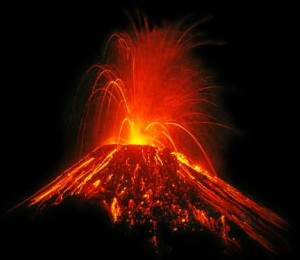Until I started doing some online research, I did not know that Texas has a number of extinct volcanoes.
In late-Cretaceous time, Central Texas was part of a vast marine shelf on which carbonate rocks were deposited with the entire area gradually subsiding as sediments were laid down. The volcano formed when magma worked its way to the surface and encountered water-laden, unconsolidated sediments with the existing water rapidly vaporizing into steam resulting in an enormous explosion that formed an explosion crater. Pilot Knob is one of around 75 late-Cretaceous Period volcanoes scattered around Central Texas from Waco to Austin, San Antonio, and Del Rio. All of these volcanoes have been extinct for millions of years.
The Pilot Knob volcanic complex consists of four small, rounded hills (including Pilot Knob proper) forming the volcano’s core area in an area two miles in diameter. The hills are composed of trap rock which is an erosion-resistant, fine-grained mafic volcanic rock.
It’s a relief to know that there is probably no threat of a volcano erupting in Texas. We have enough natural disasters without that one. However, I did find this little tidbit on the University of Texas wesite: The only real threat from a volcano for San Antonio is if a super volcano, such as the caldera under Yellowstone National Park, should erupt with a cataclysmic eruption. Such events only occur about every 100,000 years, and if there were an eruption of the Yellowstone caldera, scientists state there is little if anything that anyone from Montana to Texas could do to protect themselves.
While we may not have to worry about a volcano, earthquakes do occur in Texas. Within the twentieth century there have been more than 100 earthquakes large enough to be felt; their epicenters occur in 40 of Texas’s 257 counties. Four of these earthquakes have had magnitudes between 5 and 6, making them large enough to be felt over a wide area and produce significant damage near their epicenters. There has been an increase in seismic activity in recent history, and some tie that to the drilling method of fracking. In this method, millions of gallons of chemically treated water are forced underground to break up rock and free trapped gas. Most of the drilling fluid returns to the surface where it is either recycled or disposed of in underground wells.
Researchers think an increase in waste water injected into the ground by drilling operators may be the cause of a sixfold increase in the number of earthquakes that have shaken the central part of the U.S. from 2000 to 2011, according to a U.S. Geological Survey study. U.S. Geological Survey researchers found that, for three decades prior to 2000, seismic events in the nation’s midsection averaged 21 a year. They jumped to 50 in 2009, 87 in 2010 and 134 in 2011, according to the study, which was presented April 18 at the annual meeting of the Seismological Society of America.
Source – Bloomberg.com


Scary. Man should not mess with the natural balance.
So true, LD. I have been touting that philosophy for a long time.